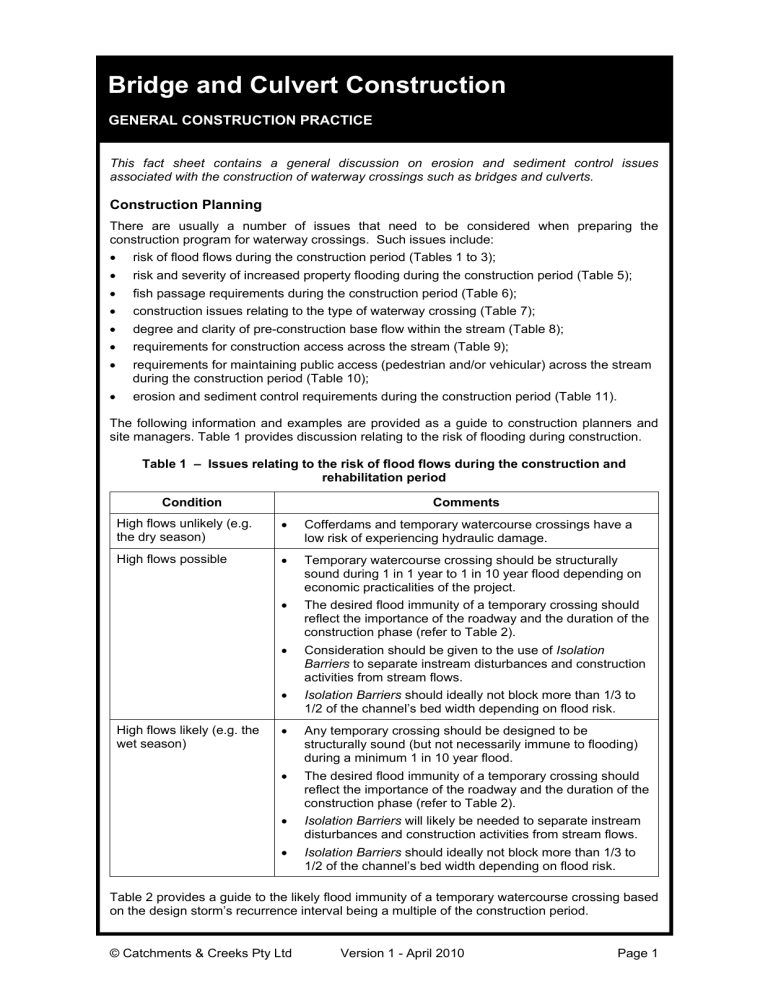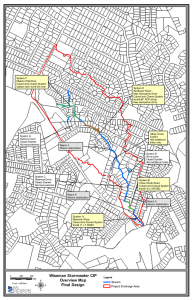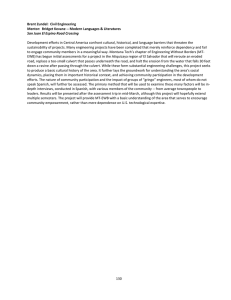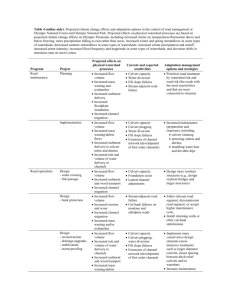
Bridge and Culvert Construction GENERAL CONSTRUCTION PRACTICE This fact sheet contains a general discussion on erosion and sediment control issues associated with the construction of waterway crossings such as bridges and culverts. Construction Planning There are usually a number of issues that need to be considered when preparing the construction program for waterway crossings. Such issues include: • risk of flood flows during the construction period (Tables 1 to 3); • risk and severity of increased property flooding during the construction period (Table 5); • fish passage requirements during the construction period (Table 6); • construction issues relating to the type of waterway crossing (Table 7); • degree and clarity of pre-construction base flow within the stream (Table 8); • requirements for construction access across the stream (Table 9); • requirements for maintaining public access (pedestrian and/or vehicular) across the stream during the construction period (Table 10); • erosion and sediment control requirements during the construction period (Table 11). The following information and examples are provided as a guide to construction planners and site managers. Table 1 provides discussion relating to the risk of flooding during construction. Table 1 – Issues relating to the risk of flood flows during the construction and rehabilitation period Condition Comments High flows unlikely (e.g. the dry season) • Cofferdams and temporary watercourse crossings have a low risk of experiencing hydraulic damage. High flows possible • Temporary watercourse crossing should be structurally sound during 1 in 1 year to 1 in 10 year flood depending on economic practicalities of the project. • The desired flood immunity of a temporary crossing should reflect the importance of the roadway and the duration of the construction phase (refer to Table 2). • Consideration should be given to the use of Isolation Barriers to separate instream disturbances and construction activities from stream flows. • Isolation Barriers should ideally not block more than 1/3 to 1/2 of the channel’s bed width depending on flood risk. • Any temporary crossing should be designed to be structurally sound (but not necessarily immune to flooding) during a minimum 1 in 10 year flood. • The desired flood immunity of a temporary crossing should reflect the importance of the roadway and the duration of the construction phase (refer to Table 2). • Isolation Barriers will likely be needed to separate instream disturbances and construction activities from stream flows. • Isolation Barriers should ideally not block more than 1/3 to 1/2 of the channel’s bed width depending on flood risk. High flows likely (e.g. the wet season) Table 2 provides a guide to the likely flood immunity of a temporary watercourse crossing based on the design storm’s recurrence interval being a multiple of the construction period. © Catchments & Creeks Pty Ltd Version 1 - April 2010 Page 1 Table 2 – Probability (%) of one or more exceedances during the construction period Duration of construction X years [1] [2] [2] Design storm average recurrence interval (ARI) [1] 0.5Xyr Xyr 2Xyr 5Xyr 10Xyr 20Xyr 50Xyr 86% 63% 39% 18% 10% 5% 2% For example, the probability of one or more 1 in 1yr floods occurring within any 1yr period is 63% (i.e. X = 1), and the probability of one or more 1 in 2yr floods occurring within any 2yr period is also 63% (i.e. X = 2). The probability of one or more 1 in 1yr floods occurring within a 2yr period is 86% (X = 2), and the probability of one or more 1 in 10yr floods occurring within a 2yr period is 18% (X = 2). If the duration of the construction phase is less than 1 year, then the probability of exceedance will increase if construction occurs during the wet season, and decrease if construction occurs during the dry season. Exposed bed and bank areas need to be rehabilitated as soon as practicable to prevent, or at least minimise, the risk of environmental harm caused by long-term soil erosion. Channel banks should be actively revegetated rather than just waiting for natural regeneration. Revegetation is one of the most successful long-term stabilisation techniques for both rural and urban waterways. In-stream ecology is greatly enhanced by the re-establishment of riparian vegetation (of local provenance), especially bank vegetation. Riparian vegetation has numerous benefits including shading for water temperature control, the establishment of habitat diversity, the creation of snags, and the linking of aquatic and riparian habitats. Wherever reasonable and practicable, bank vegetation should extend to the water’s edge to increase the value and linkage of aquatic and riparian habitats. During the revegetation phase it may be necessary to protect exposed banks from short-term erosion with the aid of Erosion Control Blankets, Mats or Mesh. Erosion control blankets or mats reinforced with synthetic mesh are not recommended for use along waterways due to their potential threat to ground-dwelling wildlife. In the absence of a locally adopted risk assessment procedure, Table 3 provides a default erosion risk rating system for major drainage channels and watercourses. Best practice requirements for the clearing and progressive stabilisation of drainage channels and watercourses are provided in Table 4. Table 3 – In-bank erosion risk rating based on expected stream flow conditions Erosion risk rating Very Low [1] [2] Expected stream flow conditions [1] No rainfall or channel flow expected during plant establishment. Alternatively, average monthly rainfall of 1 to 30mm [2]. Low Light local rainfall is expected which is likely to result in only a minor increase in channel flow above the normal dry-weather flow rate. Alternatively, average monthly rainfall of 30+ to 45mm. Moderate Heavy local rainfall is expected which is likely to cause stormwater inflows into the channel and a minor increase in channel flow above the normal dry-weather flow rate. Alternatively, average monthly rainfall of 45+ to 100mm. High Medium to high-velocity in-bank flows are expected during the plant establishment period that are likely to inundate unstable, disturbed or recently revegetated channel surfaces. Alternatively, average monthly rainfall of 100+ to 225mm. Extreme Medium to high-velocity overbank or near bankfull channel flows are expected during the plant establishment period that are likely to inundate unstable, disturbed or recently revegetated channel surfaces. Alternatively, average monthly rainfall exceeds 225mm. Erosion risk rating based on worst-case of the expected flow conditions. Local rainfall can only be used as an indicator of flood risk in small to medium catchments, not large river systems. © Catchments & Creeks Pty Ltd Version 1 - April 2010 Page 2 Table 4 – Best practice channel clearing and stabilisation requirements Risk [1] Best practice requirements All cases • All reasonable and practicable steps taken to apply best practice erosion control measures to completed channel works, or otherwise stabilise such works, prior to an anticipated increase in stream flow that will inundate such areas. Very low • Channel clearing limited to maximum 8 weeks of programmed work. • Disturbed soil surfaces stabilised with minimum 70% cover [2] within 30 days of completion of works within any constructed drainage channel or waterway. • Non-completed works stabilised if exposed, or expected to be exposed, for a period exceeding 30 days. • Channel clearing limited to maximum 6 weeks of programmed work. • Disturbed soil surfaces stabilised with minimum 70% cover [2] within 30 days of completion of works within any constructed drainage channel or waterway. • Non-completed channel works stabilised if exposed, or expected to be exposed, for a period exceeding 30 days. • Channel clearing limited to maximum 4 weeks of programmed work. • Disturbed soil surfaces stabilised with minimum 80% cover [2] within 10 days of completion of works within any constructed drainage channel or waterway. • Appropriate consideration given to the use of rock protection, biodegradable Erosion Control Mesh or the equivalent, on all erodible stream banks subject to high velocity flows. • Non-completed channel works stabilised if exposed, or expected to be exposed, for a period exceeding 20 days. • Channel clearing limited to maximum 2 weeks of programmed work. • Disturbed soil surfaces stabilised with minimum 90% cover [2] within 5 days of completion of works within any constructed drainage channel or waterway. • Appropriate consideration given to the use of rock protection, biodegradable Erosion Control Mesh or the equivalent, on all erodible stream banks subject to high velocity flows. • Non-completed channel works stabilised if exposed, or expected to be exposed, for a period exceeding 10 days. • Channel clearing limited to maximum 1 week of programmed work. • Disturbed soil surfaces stabilised with minimum 90% cover [2] within 5 days of completion of works within any area of a work site. • Appropriate consideration given to the use of rock protection, biodegradable Erosion Control Mesh or the equivalent, on all erodible stream banks subject to high velocity flows. • Non-completed channel works stabilised if exposed, or expected to be exposed, for a period exceeding 5 days. Low Moderate High Extreme [1] [2] Erosion risk based on channel flow conditions (Table 3), or as directed by the relevant regulatory authority. Minimum cover requirement may be reduced if the natural cover of the immediate land is less than the nominated value, for example in arid and semi-arid areas. Tables 5 to 8 outline some of the construction issues relating to property flooding, fish passage, type of crossing structure, and the degree and clarity of base flows. © Catchments & Creeks Pty Ltd Version 1 - April 2010 Page 3 Table 5 – Issues relating to the risk of adjacent property flooding during the construction period Condition Comments Flooding would not inundate floor levels • No extra considerations. Flooding could inundate floor level of adjacent properties • Construction should avoid periods of high flood risk. • Hydraulic analysis must be performed on each stage of construction to assess flood risk. • When diverting low-flows away from some or all of a culvert’s cells, avoid any measures that will restrict the passage of flood flows. Therefore, wherever reasonable and practicable, Flow Diversion Barriers should be located well upstream of the culvert inlet. Table 6 – Issues relating to fish passage requirements Condition No fish passage requirements exist at the site Short-term interruption to fish passage is allowable No interruption to fish passage is allowable Comments • Instream sediment control measures can be constructed without risk to fish passage. • Flow bypassing can be achieved with the use of cofferdams incorporating either pumped or gravity bypass lines. • A temporary sidetrack crossing can be used as one of the cofferdams. • Temporary instream sediment controls may be employed while installing long-term sediment controls, or constructing minor instream works. • Temporary watercourse crossings and temporary sidetrack culverts may or may not need to be fish friendly. Obtain expert Fisheries advice and approval. • Consider the use of Isolation Barriers to separate construction activities from stream flows. • Temporary watercourse crossing and sidetrack culverts must be fish friendly. Obtain expert advice and approval. • Minimum hydraulic capacity of a temporary watercourse crossing should be equal to the stream’s base flow rate. Table 7 – Construction issues relating to the type of culvert Condition Comments Single pipe culvert • Two-stage fish-friendly construction may be impractical on a single pipe culvert. Single box culvert • Two-stage fish-friendly construction may be impractical on a single box culvert. • The need to form a base slab makes it difficult to construct a single cell box culvert in streams with a high base-flow, especially when fish passage must not be interrupted. Multi-cell pipe culvert • Allow for two-stage construction and the use of Isolation Barriers to separate construction works from stream flows. Multi-cell box culvert • Allow for two-stage construction and the use of Isolation Barriers to separate construction works from stream flows • Base slab must be structurally designed and detailed to allow two-stage construction. © Catchments & Creeks Pty Ltd Version 1 - April 2010 Page 4 Table 8 – Issues relating to the degree and clarity of base flows Condition Comments • Flow bypassing can be achieved with the use of cofferdams incorporating either pumped or gravity bypass lines. • A temporary sidetrack crossing can be used as one of the cofferdams. No flow but permanent pools • Fish passage requirements may exist that may prevent the use of cofferdams and flow bypassing. Minor base flow (wet creek) • Fish passage requirements are likely to exist that may prevent the use of cofferdams and flow bypassing. • Minimum hydraulic capacity of a temporary watercourse crossing should equal the stream’s base flow rate. • Choice between piped flow bypass or Isolation Barriers is likely to depend on flow rate and fish passage requirements. • Use an Isolation Barrier to construct the culvert in isolation from the stream flow. No flow (dry creek) Significant base flow Figures 1 to 4 show examples of stream flow bypass and diversion systems. It should be noted that the planning, design and construction of temporary cofferdams can be as complex as the issues relating to the permanent instream structure. Figure 1 – Cofferdam with gravity bypass pipe Figure 2 – Cofferdam with pumped bypass flow Figure 3 – Stage 1: Use of an isolation barrier for flow diversion Figure 4 – Stage 2: Relocation of isolation barrier © Catchments & Creeks Pty Ltd Version 1 - April 2010 Page 5 Photos 1 to 6 show examples of isolation barriers and flow diversion systems. An isolation barrier does not necessarily need to be impervious in order to protect an instream soil disturbance resulting from stream flows. Photo 1 – Isolation barriers formed from silt curtain Photo 2 – Isolation barrier formed from water-filled rubber dams The method used for flow diversion depends on a number of factors including the depth of water, the flow velocity and the type of construction activities. Photo 3 – Isolation barrier formed from sediment fence fabric Photo 4 – Another view of the same construction site (left) Installing utilities beneath the bed of a stream can add another level of complexity to the construction process. Photo 5 – Construction works isolated from river flows through the use of land reclamation © Catchments & Creeks Pty Ltd Photo 6 – Isolation barrier formed from sheet piling Version 1 - April 2010 Page 6 Table 9 – Issues relating to the provision of construction access across a stream Condition Comments No need for temporary watercourse crossing • No additional requirements. Temporary construction access required across stream • Possible fish passage requirements for the temporary crossing. Minimum hydraulic capacity of a temporary watercourse crossing equal to the stream’s base flow rate. • Temporary bed level (ford) crossings can introduce high sediment flows into the stream unless the creek is dry or base flows are bypassed around the crossing. Sandy channel beds may need to be reinforced with a synthetic Cellular Confinement System. Ford crossings are not normally recommended in clay-based streams. • Temporary culvert crossings can cause significant bed disturbance during installation and removal. • Temporary bridge crossings (possibly using precast box culvert bridging slabs, e.g. Photo 7) are least likely to adversely affect fish passage. Photos 7 to 10 provide examples of temporary waterway crossings for construction access. Photo 7 – Temporary bridge crossing Photo 8 – Temporary culvert crossing The use of concrete to stabilise permanent ford crossings should be avoided when crossing an alluvial stream because the fixed concrete slab can interfere with the natural downstream movement of the bed material. Photo 9 – Ford crossing © Catchments & Creeks Pty Ltd Photo 10 – Causeway crossing Version 1 - April 2010 Page 7 Table 10 – Issues relating to vehicular access across the stream during construction Condition Comments No traffic • No additional requirements. Traffic via temporary side road • Fish passage requirements may need to apply to the side road crossing. Traffic via adjacent dualcarriage roadway • Possible use of the land between the two roads as a sediment trap/basin. Traffic needs to be maintained on the road being built • Construction of culvert must be staged. Expansion of an existing culvert: Figures 5 to 8 provide an example of the staged expansion of an existing culvert while maintaining public access across the waterway. Figure 5 – Existing culvert Figure 6 – Stage 1: Partial construction of culvert Figure 7 – Stage 2: Partial construction of culvert Figure 8 – Stage 3: Relocate traffic and final culvert construction Figures 9 to 13 provide an example of the staged construction of a new culvert while providing public access across the waterway. Figures 14 to 18 provide an example of the staged construction of a new culvert while providing public access across the waterway and achieving sediment retention within the bounds of the road reserve. © Catchments & Creeks Pty Ltd Version 1 - April 2010 Page 8 Construction of new culverts: Figure 9 – Stage 1: Construct half of access track Figure 10 – Stage 2: Construct rest of access track Figure 11 – Stage 3: Construction of half culvert Figure 12 – Stage 4: Finish culvert Figure 13 – Stage 5: Construct roadway Figure 14 – Stage 1: Construct access track and first phase of culvert Figure 15 – Stage 2: Construct second phase of culvert Figure 16 – Stage 3: Relocate access track and third phase of culvert © Catchments & Creeks Pty Ltd Version 1 - April 2010 Page 9 Figure 17 – Stage 4: Finish culvert and construct half of the roadway slowly backfilling the Sediment Basins Figure 18 – Stage 5: Finish construction of roadway and remove all sediment basins Table 11 outlines some of the issues relating to sediment control practices associated with the construction of watercourse crossings. Table 11 – Issues relating to sediment control during the construction period Condition Comments All cases • Avoid the adoption of construction practices that require the use of instream sediment trap, instead, sediment should be trapped in off-stream trap. This may require sediment-laden water to be pumped to overbank basins. Space is available for offroad Sediment Basins • Sediment traps/basins formed each side of road, each side of the stream (Figure 19). • Sediment traps operational during all stages of construction and revegetation. • Possible retention of sediment traps as permanent stormwater treatment system (Photos 13 & 14). • Consideration given to the formation of sediment traps/basins within the road reserve each side of the culvert. These sediment basins will be slowly backfilled as earthworks are completed (Figures 14 to 18). No room available for offroad Sediment Basins Use of instream sediment control measures: Instream sediment controls are installed to treat only the dry-weather base flow passing down the channel. It is rarely practical to design instream sediment controls to treat stream flows resulting from storms or floods. The choice of instream sediment control technique depends on a number of variables including channel shape, flow rate, water depth, undisturbed water quality, and the duration of the works. The selection and application of various instream sediment control techniques are described within separate fact sheets. Use of off-stream sediment traps: Preference should always be given to the use of off-stream sediment traps. Sediment runoff generated outside the watercourse must be treated prior to its discharge into the channel. When constructing watercourse crossings, four sediment traps or basins are usually required, one each side of the road, on each side of the waterway (Figure 19). These off-stream sediment traps may be retained after the construction phase as permanent stormwater treatment ponds. © Catchments & Creeks Pty Ltd Version 1 - April 2010 Page 10 Figure 19 – Example of major sediment traps constructed at the four corners of the road and stream junction Due to a combination tyre wear, brake dust, oils and metal fibres, stormwater runoff from roads potentially represents one of the most polluted forms of stormwater. Bridge crossings can generate above average concentrations of oils as vehicles bounce over expansion joints. To help control these pollutants, it is common for construction phase sediment basins to be retained as permanent stormwater treatment ponds as shown in Photos 13 and 14. Photo 11 – Excavated sediment trap associated with culvert construction Photo 12 – Bridge construction showing one of four rock filter dam sediment traps Figure 13 – Sediment basin adjacent a new culvert crossing Photo 14 – Construction sediment basins retained as permanent stormwater treatment ponds © Catchments & Creeks Pty Ltd Version 1 - April 2010 Page 11 Figures 20 to 27 present an example of staged erosion and sediment control practices on a bridge construction. Figure 20 – Stage 1: Install sediment basins in instream isolation barrier Figure 21 – Stage 2: Stabilised channel bank after completion of pier Figure 22 – Stage 3: Commence revegetation of channel banks Figure 23 – Stage 4: Install drainage works and start land clearing © Catchments & Creeks Pty Ltd Version 1 - April 2010 Page 12 Figure 24 – Stage 5: Commence filling of approach ramps Figure 25 – Stage 6: Stabilise the approach ramp batters Figure 26 – Stage 7: Construct bridge Figure 27 – Stage 8: Final site revegetation © Catchments & Creeks Pty Ltd Version 1 - April 2010 Page 13



